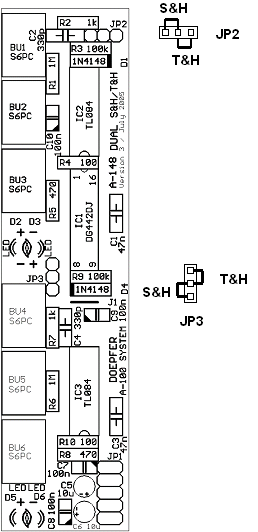A-148 Dual Sample&Hold / Track&Hold
A-148 online
tutorials by Raul Pena:
A-148 Sample and Hold: http://www.youtube.com/watch?v=m9auf7dpMrU
A-148 More Sample and Hold: http://www.youtube.com/watch?v=aHCmndbxyII
A-148 Track and Hold: http://www.youtube.com/watch?v=OwvezSuVvm4
A-148 More Track and Hold: http://www.youtube.com/watch?v=djv9RMvsRDc
A-148 Track and Hold Vs. Sample and Hold: http://www.youtube.com/watch?v=KvjiKzBaTAs
A-148 Sample Rate Reduction using T/H and S/H: http://www.youtube.com/watch?v=_on8klFYUY0
A-148 Using other Waveforms in T/H and S/H: http://www.youtube.com/watch?v=aX7k9UPQJ2M
 |
|
|
Vintage Edition |
Das Modul A-148 (Dual S&H)
enthält zwei getrennte Abtast/Halte-Schaltungen (engl. sample & hold) zur Erzeugung
treppenförmiger Steuerspannungen. Das Signal am Sample-Eingang wird im Rhythmus des am
Trigger-Eingangs anliegenden Signals abgetastet (sample) und steht zwischengespeichert
(hold) am S&H-Ausgang zur Verfügung.
Die Form der vom S&H-Modul generierten Treppenspannung hängt von der Form des am
Sample-Ein-gang anliegenden Signals ab: zufällige Treppenmuster entstehen z.B. beim
Anliegen von NOISE oder RANDOM; ansteigende und abfallende Treppen entstehen z.B. beim
Anliegen eines LFO-Signals. Zwei LED's pro Einheit dienen zur Kontrolle des gesampelten
Spannungswertes (positiv oder negativ).
S&H-Einheiten werde häufig zur Frequenzsteuerung von Filtern verwendet. In Verbindung
mit einem MIDI-Interface (A-190) und ggf. einem Clock-Teiler (A-160) können die
S&H-Stufen dabei MIDI-synchron angesteuert werden.
Die deutsche Bedienungsanleitung ist als PDF-Datei auf unserer Website verfügbar: A148_Anl.pdf
Ähnliche Module: A-152 Voltage Addressed Track&Hold / Switch (Multiplexer) / Digital Outputs
Seit August 2005 wird das Modul A-148 in einer verbesserten Version
produziert: Bei jedem der beiden Sub-Module kann mit Hilfe eines Jumpers (Steckbrücke) festgelegt werden, ob die betreffende
Einheit als Sample&Hold oder als Track&Hold arbeitet. Bei Track&Hold
folgt das Ausgangssignal dem Eingangssignal solange das Triggersignal auf
"high" ist. Geht das Triggersignal auf "low", so wird die
letzte Analogspannung gespeichert. Im Auslieferungszustand wird die obere
Einheit als S&H, die untere als T&H ausgeliefert. Am Ende dieser Seite
finden Sie die Funktion der Steckbrücken. Außerdem können mit
der neuen Version des A-148 Steuersignale im vollen A-100 Spannungsbereich von
-12...+12V bearbeitet werden und nicht nur im Bereich -8...+8V, wie bei der
alten Version.
Die beiden Versionen
können an Hand folgender Details unterschieden werden:
Version 1: vier integrierte Schaltungen (2 x CD4053, 2 x TL064 oder TL084)
Version 2: drei integrierte Schaltungen (1 x DG442, 2 x TL084), siehe
Bestückungsdruck am Ende dieser Seite.
Das folgende Dokument beschreibt die Funktionen und Positionen der Steckbrücken (Jumper) sowie interne Normalisierungs-Möglichkeiten des Moduls: A148_jumper_and_normalling.pdf
Technischer Hinweis: Die S&H-, bzw. T&H-Funktion wird rein analog mit Hilfe eines elektronischen Schalters gefolgt von einem Haltekondensator mit Pufferschaltung realisiert. Die Spannung am Ausgang driftet in der Haltephase, da sich der Kondensator allmählich über parasitäre Widerstände entlädt. Die Drift liegt typischerweise bei ca. 30 mV/Minute und hängt auch von Umgebungsfaktoren wie z.B. der Luftfeuchtigkeit ab. Für das lange Halten von CV-Signalen, die zur Tonhöhensteuerung von VCOs verwendet werden, ist das Modul daher nur bedingt geeignet.
Module A-148 (Dual S&H) has two identical
sample & hold modules, designed to produce 'staircase' voltages. The signal present at
the sample input is sampled at a rate set by the signal at the trigger input, and held at
that voltage at the S&H output.
The exact shape of the staircase depends on the sort of waveform at the sample input:
NOISE or RANDOM signals produce random patterns; an LFO produces rising or falling
staircase patterns.
Two LEDs for each S&H indicate the voltage (positive or negative) of the sampled
signal.
For more detailed information please look at the English user's manual: A148_man.pdf
Similar modules: A-152 Voltage Addressed Track&Hold / Switch (Multiplexer) / Digital Outputs
Since August 2005 an improved version
of the module is manufactured: For each sub-module the operation mode S&H
(sample&hold) or T&H (track&hold) can be selected by a jumper. In
T&H mode the output signal follows the input signal while the trigger input
is "high". As soon as the trigger input turns to "low" the
last voltage is stored. The factory setting is S&H for the upper device and
T&H for the lower device. At the bottom of this page the function of
the jumpers is described.
In addition the complete A-100 voltage range
-12...+12V can be processed (no longer limited to -8...+8V as for the previous
version).
The two versions can be identified by these details:
Version 1: four integrated circuits (2 x CD4053, 2 x TL064 oder TL084)
Version 2: three integrated circuits (1x DG442, 2 x TL084), see silk screen at
the bottom of this page.
The following document shows the positions and functions of the jumpers and internal normalling options of the module:A148_jumper_and_normalling.pdf
Technical note: The S&H/T&H function is realized by pure analog circuitry (electronic switch followed by a holding capacitor and buffer). Consequently the output voltage drifts a bit in the holding state because the capacitor is discharged by parasitic resistors. The typical drift we measured is about 30 mV/minute and depends also upon environmental conditions like humidity or temperature. For the storage of control voltages over a long time used to control the pitch of a VCO the module is suitable to only a limited extent.
Breite/Width: 4 TE / 4 HP / 20.0 mm
Tiefe/Depth: 30 mm (gemessen ab der
Rückseite der Frontplatte / measured from the rear side of the front panel)
Strombedarf/Current: +20mA (+12V) / -20mA (-12V)
Preise
/ Prices:
Standard Version
: Euro 70.00
Vintage Edition : Euro 80.00
The price in US$
depends upon the exchange rate between Euro and US$ at the payment day.


